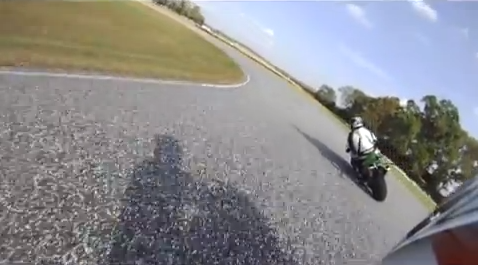
My Life As a Movie: The Dave and Jeff Hunt Story
Editor’s note: Through March, Jennifer Niesslein (@jniesslein) is contributing interviews with interesting, “ordinary” people, who do extraordinary things worthy of the big screen—to complement our Winter 2013 issue. This installment features two brothers, Dave and Jeff Hunt.
———
Pitch: In 1990, brothers Dave and Jeff Hunt were in a motorcycle accident that left Dave with a spinal cord injury and in a wheelchair. Seventeen years later, they both started riding again.
Were you close growing up?
Jeff: We had our own sets of friends and our own interests, but when it came to skiing or riding bikes, I’d say we were close.
Dave: One of the things that kept us close were family vacations—skiing in the wintertime and water-skiing in the summertime.
Who got into motorcycles first?
D: I got into it first, then Jeff.
J: I got one my senior year of high school, this tiny thing that barely went fifty miles an hour. I started small but I soon learned that the crashes hurt just as much. The resounding theme you’ll find here is that a lot of the activities we do together involves going fast—whether it’s skiing or motorcycles or cars or skydiving. We didn’t spend a lot of time as kids painting together or reading novels.
Where were you when the accident in 1990 happened? Can you talk just a little about it?
J: In Virginia on Route 211. August 14, 1990, two days before I was to go to college at West Virginia University, and we thought we’d just go for a fun little ride. At the time we thought we slipped on gravel, just because of the way we crashed, going around a corner and the front tire just completely going out, but now that we’ve learned a lot more about motorcycles and how they work, I think it was just going too fast around a corner and hitting the front brake too hard.
D: Yeah, and it doesn’t help that we get somewhat competitive. We were generally careful, but the thing about riding a motorcycle is you have to make good decisions one hundred percent of the time—one bad decision can cause a bad problem. We went all the way to the top of this mountain—although it wasn’t really a mountain—and we were on the last part of the road before the regular highway to go home.
Whose idea was it to start riding again?
D: In 1999, I saw a newspaper article of guy who had a setup that allowed him to ride. I got in touch with him, and he sent me a videotape of what he built. So I got a motorcycle, and I was going to set it up. I never got around to it and couldn’t quite figure out how to do it, so I sold the motorcycle. Then in 2007, in the summertime, my friends down here in Georgia would all go riding, and I got kind of bored sitting at home watching everyone take off, and I thought, you know, I’m going to give this a try again. The thing that I had in 2007 that I didn’t have in 1999 was YouTube. I found a guy in South Africa who had the same setup I did, and I contacted him. I asked if he’d answer questions like what sort of material to use for the bar, what actuator he used, that sort of thing. A friend of mine knew a machinist, so I made some of the parts out of balsa wood, and I gave it to the machinist so he could cut it out of aluminum. I put it all together and gave it a try in the neighborhood.
J: I rode it first and then he got on it. We took a video of it, and we were kind of holding our breath as the little bars came up and he rode away. I’m running alongside him and then he got going too fast. I just stood there and hoped for the best. He slowed down, the wheels came back down, and we’ve never looked back since.
Dave, tell me about the contraption you built onto your bike.
D: I push a button and the wheels come up, then it’s riding a regular motorcycle. When you slow down to, say, five miles an hour, you can put the wheels back down.
J: It’s basically a U-shaped bar with rollerblade wheels on the ends. It’s a pretty neat contraption. It certainly draws a lot of attention when we ride now at the racetracks. We don’t ride on the street anymore.
Do you feel comfortable with the attention?
J: I think it’s cool. At first people don’t know what the heck it is. It’s funny because at the track every morning, they have a riders’ meeting. Everybody’s down there—most of us have our leather suits on and our boots, and they’re giving us the instruction. And Dave’s in a wheelchair and I see people looking, wondering what’s going on here. Inevitably throughout the day people start coming up and saying, “Holy crap, I can’t believe that! I didn’t know what your situation was, and I’m going down the straightaway and you come blasting by me.” People know who Dave is, and I’m just Dave’s brother.
D: It’s cool especially when someone knows somebody who’s been in an accident and they’re like, “Man, I know my friend would want to try it.” I make a lot of contacts that way. I have a couple videos on YouTube, and I’ll get e-mails from all over the world—South America, countries in Asia, Europe, everywhere. I’ve talked to a couple of people who’ve gone from wanting to do it to actually doing it.
Does it feel life-changing to ride again?
D: That’s the exact phrase I would use. It … it feels normal. It’s what I like to do. If you’ve got a situation like this where you’re injured and it limits what you can do, it puts a damper on things. You might have to do it a little differently. You might have to give it more effort, but taking back what you like to do completely changes your life, every aspect of it.
What did your parents say when you started riding again?
D: We got the thing built, and I rode it, and I sent my dad the video. I hadn’t told him. And he didn’t know what he was looking at. He said, “What’s that?” And I said, “That’s me, riding a motorcycle.”
J: It was almost a Don’t Ask Don’t Tell thing. I’m sure they weren’t thrilled for the obvious reasons—they’ve seen what motorcycles can do to people. It was difficult in the years after his accident because there wasn’t a whole lot that he and I could still do together. So for seventeen years, Dave and I would hang out, watch TV, go to a restaurant. And while it’s great to hang out, there was this void of being the brothers who do cool things together. There wasn’t any excitement. Once he got back into motorcycles and I decided to join in on that, I think our parents were happy because they liked to see us doing things and enjoying our time together. They’re more okay with it because they see a lot of positive coming out of it.
A lot of siblings drift apart in adulthood—what do you think has kept the two of you close?
J: I was five feet behind him when we crashed, and I was the one who stood up. That set things off in a certain direction. I always thought we needed to stay close. We’ve been in constant contact—when I moved down here, he decided to, too, and then after I had kids, he was involved in their lives. But it’s the bike stuff that made me think, Okay, we got something again. We can tell the same stories. I think that’s really helped keep us close.
D: I just don’t see any other way about it. It’s odd to me when I see friends of mine with brothers and sisters and they’re not close. I have a friend from work who rode his motorcycle across the country from California to here in Georgia. His brother lives the next town over, and he didn’t even stop to see him. We’ve always been close, probably more so now than in middle school or high school.
If you imagined your lives as a movie, what kind of movie would it be?
J: It would be a pretty good action and adventure flick with some highs and some lows. It certainly wouldn’t be a drama.
D: And a lot of boring parts in between the action and adventure.
J: There would be a lot of difficult times from both of our perspectives. From your perspective, there would be just the obvious day-to-day struggles and frustrations of what you could once do and some of those limitations, but also the things you’re able to achieve that are pretty amazing. From my perspective, it’s difficult to see when you’re struggling through certain things. It would be interesting to see that on the screen.
D: Early on there were a lot more frustrations. Now that I can see certain things can be done, that frustration sort of turns into motivation. Maybe it’s because I’m older, but I can now sit back and say, “This is going to take a little bit of work, and I’ve got to figure out how I’m going to get this to happen.” Whatever the obstacle is, I can get over it if I stop and think about it for a little bit.
Who would play you in the movie?
J: This guy that I work with always calls me Jason Bourne. He thinks I look like Matt Damon. So Matt Damon because of the action movies.
D: Murdock from “The A Team”—the original “A Team.” The guy who was a little nutty, but he flew the airplanes.
———
About the author: Jennifer Niesslein (@jniesslein) is a writer and editor living in Charlottesville, Virginia; she blogs regularly for VQR. Visit her website at jenniferniesslein.com.

